Most breakfast cereals are predominantly refined grains and added sugar. And quite often a cereal that looks healthy is not. Learn what to look for when choosing a healthier breakfast cereal and what ingredients to avoid.
Criteria to consider when choosing breakfast cereal:
1. Look for fiber and whole grains
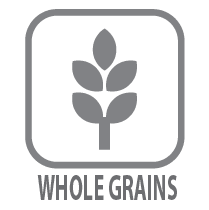
Breakfast cereals are made from processed grains.
All grains are predominantly carbohydrates, which are broken down by the body into sugar.
Whole grains include all three parts of a grain: the germ, endosperm and bran.(1)
Fiber, a key component of most whole grains, slows down the rate the body digests carbohydrates keeping you fuller longer.
The FDA recommends consuming at least 25 grams of dietary fiber a day and the American Heart Association states that “dietary fiber from whole grains, as part of an overall healthy diet, may help improve blood cholesterol levels, and lower risk of heart disease, stroke, obesity and type 2 diabetes.”(2,3)
2. Minimize refined grains

Refined grains have some portion of the grain removed (typically the bran and germ, sources of the majority of a grain’s vitamins and fiber).(1)
Depending on the food and how processed it is, the speed with which the body digests the carbohydrates is highly variable.
Highly processed carbohydrates (like those in most breakfast cereals) are broken down extremely quickly and can rapidly increase blood glucose levels.
Foods that rapidly increase blood glucose levels are known as high Glycemic Index (GI) foods.(4)
Eating a diet made up of mostly high-GI foods is associated with chronic disease and strongly associated with heart disease.
3. Minimize added sugar
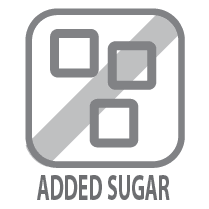
The amount of added sugar varies widely across different cereal types and brands, though most breakfast cereals could be considered vitamin fortified cookies.
Added sugar has many different names.
In cereal, typical added sugars listed in the ingredients include:
- sugar
- cane sugar
- corn syrup
- brown sugar syrup
- honey
- brown sugar
- molasses
- fructose, and
- dextrose
Read more on recommended daily intake of added sugar and why you want to minimize added sugar consumption.
4. Avoid artificial preservatives

Many breakfast cereals use vitamin E, a natural preservative, to maintain “freshness.”
However, some cereal brands use butylated hydroxytoluene (BHT), a synthetic antioxidant that, while considered safe by the FDA, is considered by the US Department of Health and Human Services to have carcinogenic potential. (5)
With non-synthetic antioxidants readily available (such as tocopherol), it is advisable to avoid foods that contain BHT.
5. Avoid artificial food coloring, including caramel color

Artificial food coloring is most widely used in sodas, candy, and baked goods.
A recent study published in the journal Clinical Pediatrics found that more than 40% of food products marketed to children contained artificial food coloring.(6)
Though considered safe by the FDA, some children have been found to have negative reactions to artificial food coloring.(7)
Additionally, many common artificial food dyes have been shown to cause allergic reactions in sensitive people.(8)
Though only small amounts of artificial coloring are used in baked goods, such as cereal, it is advisable to avoid products that contain any artificial food coloring. We discuss why it is best to avoid caramel coloring in a previous post on choosing a granola bar.
Bottom line when choosing a healthy cereal: choose a breakfast cereal that is mostly whole grains rich in fiber, has minimal added sugar, and contains ingredients you recognize.
Evaluation of top selling breakfast cereals
The top 10 selling breakfast cereals were evaluated using the criteria below.(9, 11-19)
Many cereals rich in whole grains could not be rated as “wise” simply because they contained too much added sugar. This is a very common problem with breakfast cereal.
“Avoid” does not mean we should never eat a cereal.
“Avoid” simply means that these are cereals that contain mostly, if not all, refined gains, enough sugar that they should be classified as a dessert, and often other junky ingredients.
These cereals should be considered a rare treat (or even dessert) and not a breakfast staple.
Criteria used to evaluate popular breakfast cereals
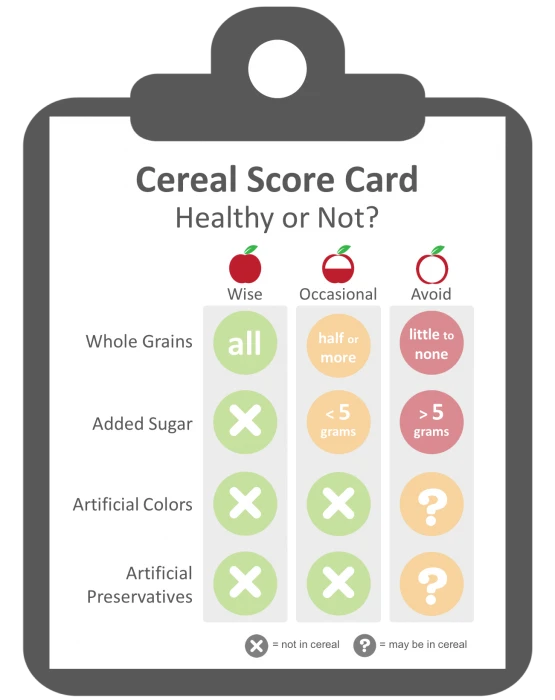
Since cereal serving sizes can vary widely from ~ 27 to 60 grams, all information below is for 30 gram servings.
The total percent added sugar is included to highlight just how much sugar is added to top selling breakfast cereals. Also included are the total grams of whole grain and fiber per serving.
Types of added sugar are listed in red. Ingredients to be concerned about are bolded.
Finally, an asterisk (*) indicates ingredients that are likely genetically engineered (learn more about GMO foods).
Choosing Healthier Cereals
Though most of the top selling breakfast cereals contain some whole grains, they are almost all loaded with added sugar.
In fact, most of the cereals contain half of the American Heart Association’s recommended daily intake of added sugar for children!
When you choose a healthier cereal for your family, try to select one that is 100% whole grains with minimal added sugar.
How do you know if a cereal is rich in whole grains?
Look to see if “whole grain” is the first ingredient on the ingredient list or if the cereal contains roughly 1 gram of fiber for every 10 grams of carbohydrates listed on the Nutrition Facts label.
None of the Top Selling Breakfast Cereals are Healthy Options
None of the top selling cereals are what we would consider healthy. This is because they are loaded with added sugar and refined flours.
Most cereals are highly processed. When cereal grains are processed into flakes, circles, and puffs, our bodies can digest the carbohydrates quickly, resulting and increases their GI value.(4,10)
Healthier cereals do not contain excess added sugar, are less processed, and have sufficient amounts of fiber to help slow down how quickly our bodies can digest them.
A few examples of healthier cereals are listed at the end of this article.
Cereals to avoid or eat only as a rare treat:
Unfortunately, many of the cereals we enjoy eating for breakfast are not healthy. These cereals contain too much added sugar, refined grains, or artificial ingredients.
Cheerios
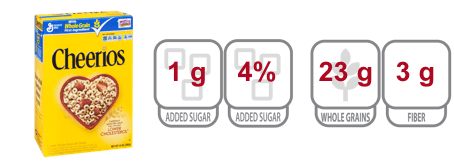
Cheerios Ingredients: whole grain oats, corn starch, sugar, salt, tripotassium phosphate, vitamin E
Are you surprised to see Cheerios are no considered healthy?
Even though Cheerios contain “100% whole grain oats”, they are NOT 100% whole grain. The second ingredient in Cheerios is corn starch. Our bodies rapidly metabolize starch into sugar, which causes a rapid spike in blood sugar levels.(4,10)
Cereals Made with Conventional Oats
Also, a recent report from the Environmental Working Group found high levels of glyphosate residue in popular cereals made from oats.(25)
While oats are not Round-up resistant, the pesticide can be sprayed on the crop to speed up drying at harvest. It is worth noting that the EWG did find glyphosate residue on organically grown oats, however the levels were significantly lower than that of conventional oats.
The safety of chronic, low-level exposure to glyphosate is not proven. Therefore, it is advisable to consume non-GMO soy and conventional oats to minimize glyphosate residue intake.
Is it okay to feed your children Cheerios? Maybe.
Personally, I would wait for General Mills to make Cheerios with pesticide-residue free oats. Cheerios are already made with oats that are certified gluten free, so it is reasonable that they can figure this out.
However, because they are highly processed and considered a high glycemic index food, they should not be an every day meal or snack.
Honey Nut Cheerios
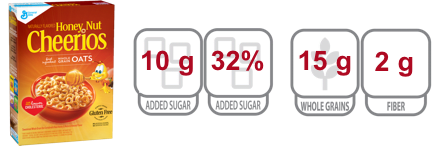
Honey Nut Cheerios Ingredients: whole grain oats, sugar*, oat bran, corn starch*, honey, brown sugar syrup, salt, trisodium phosphate, rice bran oil and/or canola oil*, natural almond flavor, vitamin E
Reasons to avoid Frosted Flakes cereal:
- 10 grams of added sugar per serving
- Made with conventional oats, so likely contains glyphosate residue
Frosted Flakes
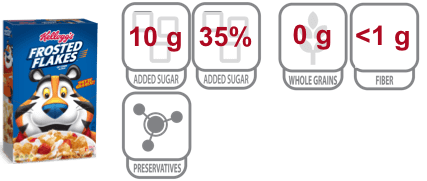
Frosted Flakes Ingredients: milled corn*, sugar*, malt flavor, salt, and BHT
Reasons to avoid Frosted Flakes cereal:
- No whole grains
- 10 grams of added sugar per serving
- Artificial preservative BHT
Honey Bunches of Oats
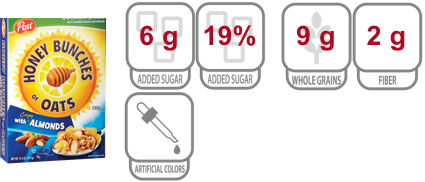
Honey Bunches of Oats Ingredients: corn*, whole grain wheat, sugar*, whole grain rolled oats, brown sugar*, almonds, rice, canola oil*, wheat flour, malted barley flour, corn syrup*, salt, whey, malted corn* and barley syrup, wildflower honey, caramel color, cinnamon, natural and artificial flavor, annatto extract
Reasons to avoid Honey Bunches of Oats cereal:
- 6 grams of added sugar per serving
- Contains caramel color
- Artificial flavors
Cinnamon Toast Crunch
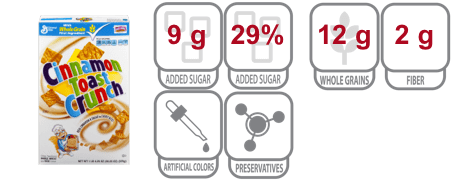
Cinnamon Toast Crunch Ingredients: whole grain wheat, sugar*, rice flour, canola oil*, fructose, maltodextrin, dextrose, salt, cinnamon, trisodium phosphate, soy lecithin*, caramel color, and BHT
Reasons to avoid Cinnamon Toast Crunch cereal:
- 9 grams of added sugar per serving
- Contains caramel color
- Artificial preservative BHT
Froot Loops
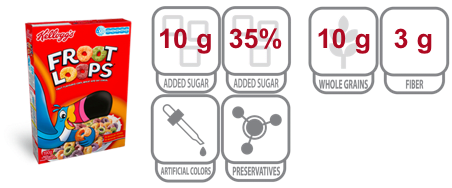
Froot Loops Ingredients: corn flour blend* (whole grain yellow corn flour, degerminated corn flour), sugar*, wheat flour, whole grain oat flour, oat fiber, modified food starch*, hydrogenated vegetable oil*, oat fiber, salt, soluble corn fiber*, natural flavor, red 40, turmeric extract color, blue 1, yellow 6, annatto extract color, and BHT
Reasons to avoid Froot Loops cereal:
- 10 grams of added sugar per serving
- Contains artificial food colors
- Artificial preservative BHT
Lucky Charms
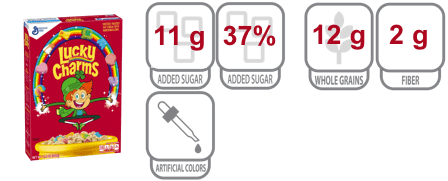
Lucky Charms Ingredients: whole grain oats, sugar*, oat flour, corn syrup*, modified corn starch*, corn starch*, dextrose, salt, gelatin, trisodium phosphate, yellows 5 & 6, red 40, blue 1 and other color added, natural and artificial flavor, vitamin E
Reasons to avoid Lucky Charms cereal:
- 11 grams of added sugar per serving
- Contains artificial food colors
- Artificial flavors
Frosted Mini Wheats

Frosted Mini Wheats Ingredients: Whole grain wheat, sugar*, brown rice syrup, gelatin, and BHT.
Reasons to avoid Frosted Mini Wheats cereal:
- 6 grams of added sugar per serving
- Artificial preservative BHT
Raisin Bran

Raisin Bran Ingredients: Whole grain wheat, raisins, wheat bran, sugar*, brown sugar syrup, salt, malt flavor
Reasons to avoid Raisin Bran cereal: contains an estimated 9 grams of added sugar per serving
It is unclear exactly how much of the sugar in Raisin Bran is natural sugar from the raisins and added sugar. Updated labeling requirements by the FDA (to come into effect in early 2020) should help clarify this.
Raisin Bran is another cereal that is often considered a healthy choice. This is probably because of the whole grain flakes and raisins.
However, Raisin Bran contains hidden added sugar in both the sugar coating on the raisins and in the flakes.
A wiser choice would be to purchase bran flakes that are low in added sugar and simply add in raisins.
Examples of healthy breakfast cereals:
To understand what healthier options for breakfast cereal look like, it is important to look past the top selling brands.
Top selling cereals are positioned at eye level on a grocery shelf, so look to the top or bottom shelves for healthier options.
Below are a few examples of wise and occasional breakfast cereal options.
Post Shredded Wheat, Spoon Size

Post Shredded Wheat Ingredients: whole wheat
Kashi 7 Whole Grain Puffs

Kashi 7 Whole Grain Puffs Ingredients: whole hard red wheat, whole brown rice, whole oats, whole barley, whole triticale, whole rye, whole buckwheat, sesame seeds.
Example healthier cereals for occasional eating:
Most cereal options, even those that appear healthier, contain some added sugar and are highly processed. For this reason, they are okay for occasional eating, but should not be a daily staple.
Whole Foods 365 Bran Flakes

Whole Foods 365 Bran Flakes Ingredients: whole wheat, wheat bran, cane sugar, barley malt extract, sea salt
Puffins

Puffins Ingredients: Corn flour, whole grain oat flour, cane sugar, oat fiber, corn bran, unsulfured molasses, sea salt, baking soda, vitamin C, vitamin E
Conclusions about breakfast cereals
Breakfast cereals are typically high glycemic index (GI) foods because of the highly processed grains and excessive amounts of added sugar. By choosing a cereal that is less processed with no added sugar, you are able to reduce the GI of a food.
It is important to eat lower GI foods because there is increasing scientific evidence that suggests that elevated blood glucose levels after meals contributes to the development of chronic disease.(24) Also, research has shown that people who eat high GI breakfasts tend to eat more calories later in the day.
So what does my family eat for breakfast? On mornings when we have cereal, we eat a combination of cereals. Everyone starts with a good helping of my homemade granola topped with some puffed grains or other no-added-sugar cereals and a sprinkling of more treaty “occasional” cereals.
Find other healthy store bought snacks and foods
Check out these other popular foods and snacks! Find out which favorite packaged foods are healthy and which ones best to avoid or enjoy as an occasional treat.
- Healthy crackers and snacks
- Healthier fruit snacks
- Healthy granola bars
- Healthy Trader Joe’s shopping list (pantry staples)
Pin article for later:
References:
- What’s a Whole Grain? A Refined Grain?, Whole Grain Council Website (link)
- FDA Recommended Daily Value for Fiber, Food and Drug Administration Website (link)
- Whole Grains and Fiber, American Heart Association Website (link)
- Always Hungry? Conquer Cravings, Retrain Your Fat Cells & Lose Weight Permanently, David Ludwig, MD, PhD (link)
- Center for Science in the Public Interest. Chemical Cuisine: BHT (link)
- Prevalence of Artificial Food Colors in Grocery Store Products Marketed to Children. A Batada, M Jacobson, Clinical Pediatrics, Vol 55, Issue 12, pp 1113-1119, 2016 (link)
- Mechanisms of behavioral, atopic, and other reactions to artificial food colors in children. L Stevens, T Kuczek, J Burgess, M Stochelski, L Arnold, L Galland, Nutr Rev (2013) 71 (5):268-281 (link)
- Center for Science in the Public Interest. Chemical Cuisine: Artificial Food Coloring (link)
- Cold cereals 2017: The top 10 brands in the first half of 2017, Bakery and Snacks Website (link)
- What We Eat, Marion Nestle, 2006 (link)
- Cheerios Nutritional Information, Cheerios Website (link)
- Honey Nut Cheerios Nutritional Information, Cheerios Website (link)
- Frosted Flakes Nutritional Information, Kellogg’s Website (link)
- Honey Bunches of Oats Nutritional Information, Post Consumer Brands Website (link)
- Cinnamon Toast Crunch Nutritional Information, Crazy Squares Website (link)
- Froot Loops Nutritional Information, Kellogg’s Website (link)
- Lucky Charms Nutritional Information, General Mills Website (link)
- Frosted Mini Wheats Nutritional Information, Kellogg’s Website (link)
- Raisin Bran Nutritional Information, Kellogg’s Website (link)
- Post Shredded Wheat Spoon Size, Post Consumer Brands Website (link)
- Kashi 7 Whole Grain Puffs Cereal, Kashi Website (link)
- 365 Everyday Value Bran Flakes, 365 by Whole Foods Website (link)
- Original Puffins Cereal, Barbaras Website (link)
- Glycemic index, postprandial glycemia, and the shape of the curve in healthy subjects: analysis of a database of more than 1000 foods. Jennie Brand-Miller, Karola Stockmann, Fiona Atkinson, Peter Petocz, and Gareth Denyer Am J Clin Nutr 2009; 98:97-105 (link)
- Breakfast with a dose of Roundup?, EWG Website, 2018 (link)
This article was originally published in February, 2017. This current version has been updated to improve readability and include the latest ingredients of the cereals evaluated.
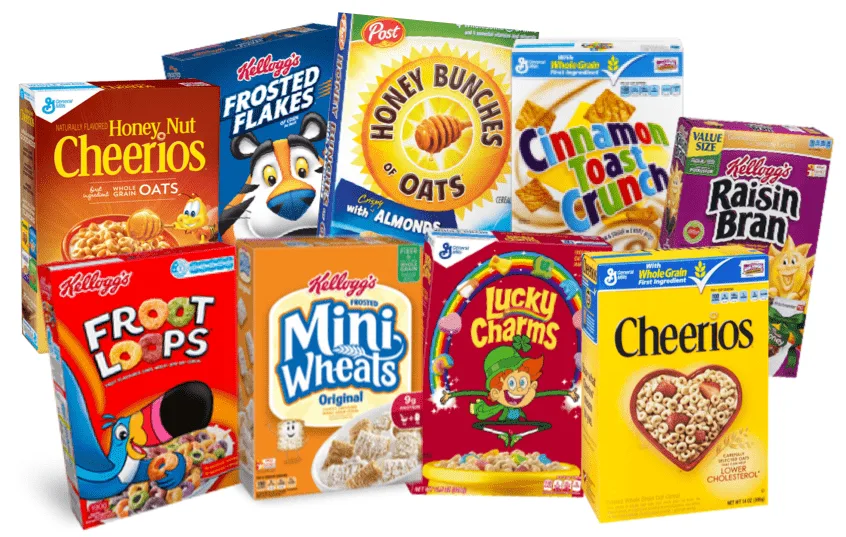

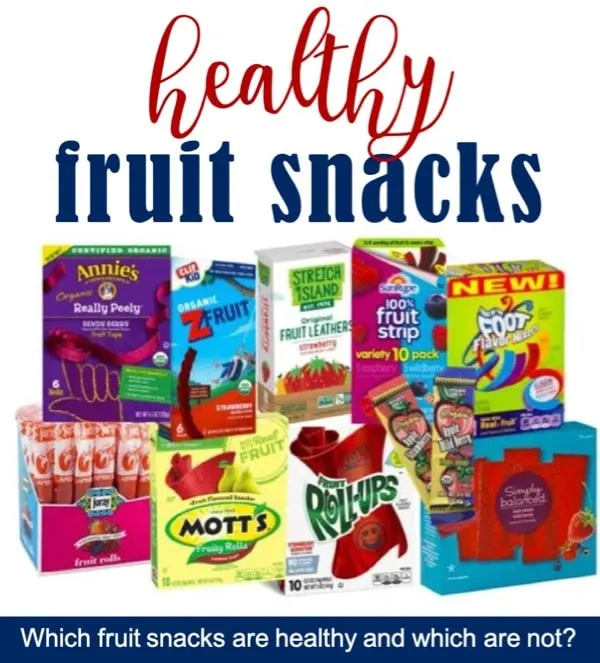


Lauren Gilbert
Saturday 15th of July 2023
What about Snoqualmie Falls Oatmeal?
What other breakfast cereals do you recommend besides cardboard tasting shredded wheat?
Since you mentioned Western Diets, what Eastern Diet items would you recommend for North American breakfasts?
Meredith
Sunday 16th of July 2023
Hi Lauren -
Snoqualmie Falls Oatmeal is simply rolled oats. I have written a post talking about oatmeal for breakfast (and potentially healthier alternatives): https://feedthemwisely.com/which-breakfast-healthier-oatmeal-omelet
Tia
Monday 16th of September 2019
Post shredded wheat has BHT
Meredith
Friday 20th of September 2019
Hi Tia - The BHT in Post Shredded Wheat is in the lining of the packaging. In theory, it may be possible for it to migrate from the packaging to the cereal. There are several store brand versions of Shredded Wheat that do not use BHT lined packaging. Thanks for your comment!
Royvia
Friday 13th of September 2019
Great post.
Tonya Robinson
Monday 5th of August 2019
Can you please tell me the national average prices for the top 10 cereals listed-standard size?
Meredith
Tuesday 6th of August 2019
Hi Tonya, cereal sizes vary widely and prices fluctuate depending on region and periodic sales. Unfortunately, this is not information that I can reliably compile. Sorry!
Natalie
Saturday 23rd of March 2019
Thank you SO, SO much!
Mike
Saturday 10th of August 2019
Avoid cereals that use glyphsate as a desicant for harvesting. Basically if it doesn't say organic, it probably has glyphsate in it.